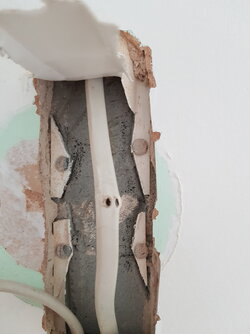- Dec 18, 2011
- 5,378
- 6,731
- 405,788
- If you're a qualified, trainee, or retired electrician - Which country is it that your work will be / is / was aimed at?
- United Kingdom
- What type of forum member are you?
- Practising Electrician (Qualified - Domestic or Commercial etc)
I have just completed an EICR.
The install is TT, Ze is 308 ohms.
Zs on all circuits is <1.5 ohm due to bonding.
There is an up front 30mA RCD which trips with the push button but does not trip when tested either at a socket, light or actually in the RCD itself.
I know the RCD is faulty as I had a spare RCBO which I used and tripped as it should.
The lighting circuit had N-E IR readings of 0.27ohms. All other circuits were >2M ohms.
My question is why did the RCBO not trip instantly when I powered up this circuit through the RCBO?
The install is TT, Ze is 308 ohms.
Zs on all circuits is <1.5 ohm due to bonding.
There is an up front 30mA RCD which trips with the push button but does not trip when tested either at a socket, light or actually in the RCD itself.
I know the RCD is faulty as I had a spare RCBO which I used and tripped as it should.
The lighting circuit had N-E IR readings of 0.27ohms. All other circuits were >2M ohms.
My question is why did the RCBO not trip instantly when I powered up this circuit through the RCBO?


 . The RCD always tested fine when tested correctly with all outgoing cables disconnected. It now even tests with them connected
. The RCD always tested fine when tested correctly with all outgoing cables disconnected. It now even tests with them connected  .
.






